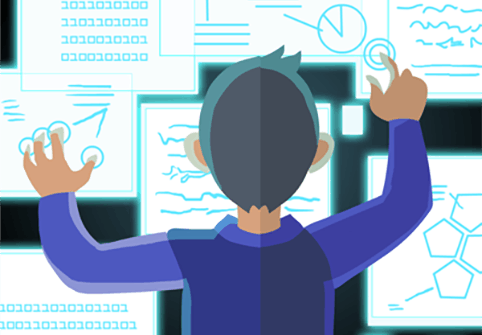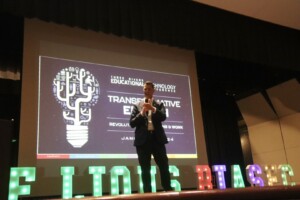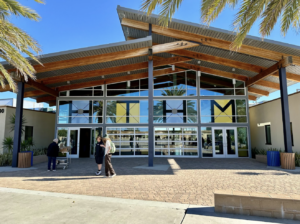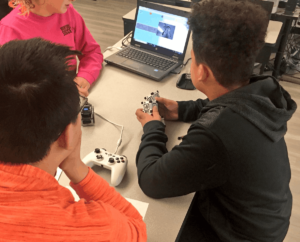Exposing Every Student To STEM

When we think about the jobs of tomorrow, we can be sure of one thing, they will be different than the jobs of today. The speed at which technology is advancing and shifting is only increasing and post secondary success will be largely dependent on the ability to navigate a dynamic path. We have to prepare kids for jobs that do not yet exist and the best way to do this is to build critical thinkers and problem solvers that are curious, persistent and dedicated.
Part of developing students that are future ready means encouraging them to make connections to their own interests and to bridge the gap between different content areas through projects that excite and engage. In this blog, Mark Elgart shares how STEM education for all, not just those interested in STEM careers will be key to developing such skills. This post originally ran on TechCrunch.
Mark Elgart
According to the National Center for College and Career Transitions (NC3T), about 20 percent of careers — and many of the fastest growing areas — directly relate to science, technology, engineering and math.
But by one count, an insufficient number of students today will pursue STEM careers. So how do we convince students that STEM is important even if they don’t think they will pursue a career in a related field?
“To varying degrees, every workplace is being transformed by enabling technologies,” writes NC3T President Hans Meeder.
Understanding technology is becoming an expectation in all roles within the workforce and as the workplace continues to evolve, everyone needs the critical-thinking and problem-solving skills that STEM education fosters.
Put simply, to be an informed citizen requires careful, methodological thinking to navigate the world successfully—financial decisions, health issues, parenting as well as making sense of politics and polls. No wonder, then, that Meeder argues “life skills are really STEM skills.”
“Everything we know about the way the world is evolving is saying that STEM is becoming a more important part of not only the technology sector, but every sector of the economy—and, frankly, solving most of the world’s most important problems,” Shelton says. “So STEM education is important for every student, no matter what they want to do in life.”
What does it mean to be STEM literate? It means understanding the fundamental concepts and approaches used in science, engineering, technology and math—concepts such as the scientific method and how to frame and then solve abstract problems. It also means grasping the extent to which these STEM skills are needed in a broad spectrum of careers, including the growing number of middle-wage jobs that require some college or credentials, but not necessarily a traditional four-year college degree.
In adolescence, “you start developing ideas of what you’re good at,” says Yvonne de la Peña, Ed.D., director of learning and engagement for CodeNow, a nonprofit program that helps introduce less advantaged students to technology. “If you never have the opportunity to try something like programming, you may never realize you’re really good at it.”
The question, then, is how do we expose all students to STEM—if a four-year degree, much less a career in technology, isn’t on their radar screens? This question is especially critical in middle school and high schools, when students begin making their own decisions about what classes they take and what subjects they study.
More importantly, students may not understand the connection between STEM subjects and the future careers they are interested in. As part of AdvancED STEM Certification, we have reviewed and certified schools that have the qualities and components vital to creating and sustaining superior, student-centered K-12 STEM teaching and learning programs.
We have found that schools that weave technology into other subject areas in authentic ways and set clear expectations for student outcomes are helping their students make the connection between STEM and 21st century skills.
At Logan High School in Ohio, for example, students in advanced biomedicine classes investigate real-world medical problems by using data acquisition software to monitor body functions, including respiration and blood pressure, in a variety of settings. Along with getting hands-on biology experience, these students quickly learn the value of technology in what can literally be life-or-death situations.
Quality STEM programs like the one at Logan High School provide important benefits. They expose students to real-world science while encouraging students to think and work with the mindset of a STEM professional—solving interdisciplinary problems that require problem identification, investigation and analysis.
As was the case with CodeNow alumni Wilfried Hounyo, these programs also help students understand just how pervasive skills like computer programming are, and the connections these skills have to everything around them.
“You can use coding for so much more than I realized,” Hounyo says.
Those of us in the technology sector are all too aware of the growing challenges of finding, training and retaining skilled workers. Ensuring that all students, not just the future computer science majors, are exposed to skills like programming could be the best way to broaden and improve skills within our workforce.
One of the most exciting approaches to bring more students into STEM fields is happening not in K-12 schools, but in the nation’s community colleges that are establishing career and academic pathways to bring students into fast-growing career fields.
By offering the growing numbers of students who attend two-year colleges a more cohesive and focused course of study in which they can gain academic and career skills in tandem, students can grasp why they need specific STEM classes—say, computer science to pursue a career in business operations, or algebra to become a civil engineer—to reach their career goals. Finding ways to do something similar in middle school or the early years of high school could help more students connect STEM skills to their own personal goals, resulting in a smarter, more STEM-literate workforce.
“I think every kid has their own special interest,” Hounyo says. “If you can find a way to tie programming into it, it’s a good way for them to learn it.” Our challenge, our opportunity is to help every student discover how STEM skills can be the foundation for success throughout their life no matter the pathway.
For More on cross-curricular student-centered and project based learning, check out:
- Personalizing and Guiding College and Career Readiness
- Deeper Learning as a Turn Around Strategy
- Preparing Students for a Project Based World

Mark Elgart, Ed.D. is President and CEO of AdvancEd. Follow Mark on Twitter, @MarkElgart.







Steele Honda
Thanks for pointing out that one of the benefits of STEM programs is that they expose students to real-world science while encouraging students to think and work with the mindset of a STEM professional. I think that it's important to get high school and middle school kids engaged in STEM so that when they go on to pursue higher learning they know what their options are and what they can do with those interests. I think it would be a smart idea to have a fun high school science program that would get kids interested and involved early on.